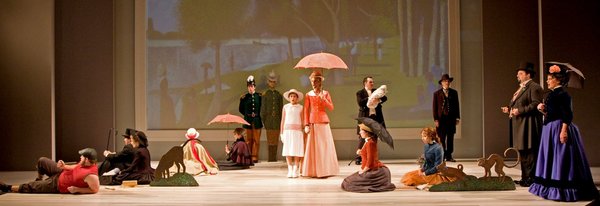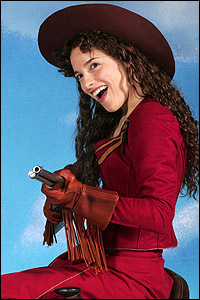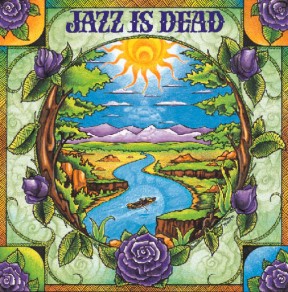No sooner did I return from my vacation than I hit the road again. Today’s Wall Street Journal drama column is devoted to reviews of two out-of-town musicals, Sunday in the Park with George in Philadelphia and Annie Get Your Gun in Connecticut. Both are top-notch, must-see shows. Here’s an excerpt.
* * *
For all the prodigal virtuosity of his wordplay, Stephen Sondheim is first and foremost a composer. It is his music that makes his shows unique, and it troubles me that so many of the small-scale Sondheim revivals to come along in recent seasons have fallen down on the musical job. Not so the Arden Theatre Company’s sterling mounting of “Sunday in the Park with George,” in which Mr. Sondheim and James Lapine spin a tale of love, loss and artistic commitment out of the creation of “A Sunday Afternoon on the Island of La Grande Jatte,” Georges Seurat’s 1886 pointillist masterpiece. Not only is this production sensitively staged and imaginatively designed, but it’s the best-sung Sondheim revival to come along in years–and it makes use of Michael Starobin’s ear-caressingly iridescent original 1984 orchestrations, which are among the finest ever to be created for a Broadway show.
 The program gives joint credit for the concept of this production to Terrence J. Nolen, the director, and Jorge Cousineau, who created the video projections that bring “Sunday in the Park with George” to arresting visual life. On a stage designed by James Kronzer to look like a triple-matted print hanging in an art gallery, we see the sketches from Seurat’s notebooks on which “A Sunday Afternoon on the Island of La Grande Jatte” was based, along with countless other striking effects. What is most impressive, though, is that none of these effects is ever allowed to get between the actors and the audience: Instead of overwhelming the show, they serve it….
The program gives joint credit for the concept of this production to Terrence J. Nolen, the director, and Jorge Cousineau, who created the video projections that bring “Sunday in the Park with George” to arresting visual life. On a stage designed by James Kronzer to look like a triple-matted print hanging in an art gallery, we see the sketches from Seurat’s notebooks on which “A Sunday Afternoon on the Island of La Grande Jatte” was based, along with countless other striking effects. What is most impressive, though, is that none of these effects is ever allowed to get between the actors and the audience: Instead of overwhelming the show, they serve it….
 No two musicals could be more unalike than “Sunday in the Park with George” and Irving Berlin’s “Annie Get Your Gun,” a make-way-for-Merman blockbuster with a score that piles hit atop hit and a charmingly cartoonish book by Herbert and Dorothy Fields that is as child-friendly as a sandbox on a sunny day. Now Goodspeed Musicals is putting on this well-loved show as a vehicle for Jenn Gambatese, who made a splash in “All Shook Up” and “Tarzan” but has yet to emerge as a name-above-the-title musical-comedy star. If Rob Ruggiero’s terrific production were running on Broadway, it’d surely do the trick: Ms. Gambatese has a platinum-plated voice and a smile warm enough to sell tickets all by itself, and she plays Annie Oakley, the sharp-shooting backwoods gal who cain’t get a man with a gun, with an affecting blend of brassy boldness and unexpected vulnerability. This is the kind of performance on which whole careers are built….
No two musicals could be more unalike than “Sunday in the Park with George” and Irving Berlin’s “Annie Get Your Gun,” a make-way-for-Merman blockbuster with a score that piles hit atop hit and a charmingly cartoonish book by Herbert and Dorothy Fields that is as child-friendly as a sandbox on a sunny day. Now Goodspeed Musicals is putting on this well-loved show as a vehicle for Jenn Gambatese, who made a splash in “All Shook Up” and “Tarzan” but has yet to emerge as a name-above-the-title musical-comedy star. If Rob Ruggiero’s terrific production were running on Broadway, it’d surely do the trick: Ms. Gambatese has a platinum-plated voice and a smile warm enough to sell tickets all by itself, and she plays Annie Oakley, the sharp-shooting backwoods gal who cain’t get a man with a gun, with an affecting blend of brassy boldness and unexpected vulnerability. This is the kind of performance on which whole careers are built….
* * *
Read the whole thing here.
Archives for June 2010
TT: The zero option
The Pasadena Symphony is the latest regional orchestra to get itself into financial hot water. It won’t be the last. So many second- and third-tier American orchestras are currently struggling to survive that I’ve been asking myself, not for the first time, whether such institutions may possibly have outlived their artistic usefulness. Do regional orchestras make artistic sense now that the ubiquity of downloadable digital music has rendered obsolete their historic function of bringing classical-music masterpieces to smaller communities? Or can these floundering ensembles be successfully “repurposed” for the twenty-first century?
These tough questions are the subject of my “Sightings” column in Saturday’s Wall Street Journal. If, like me, you wonder whether and why regional orchestras ought to be saved, pick up a copy of Saturday’s paper and see what I have to say.
UPDATE: Read the whole thing here.
TT: Almanac
“He that lives upon Hope will die fasting.”
Benjamin Franklin, Poor Richard’s Almanack
TT: So you want to see a show?
Here’s my list of recommended Broadway, off-Broadway, and out-of-town shows, updated weekly. In all cases, I gave these shows favorable reviews (if sometimes qualifiedly so) in The Wall Street Journal when they opened. For more information, click on the title.
Warning: Broadway shows marked with an asterisk were sold out, or nearly so, last week.
BROADWAY:
• La Cage aux Folles * (musical, PG-13, adult subject matter, reviewed here)
• Fela! * (musical, PG-13, adult subject matter, reviewed here)
• Fences * (drama, PG-13/R, adult subject matter, closes July 11, reviewed here)
• Million Dollar Quartet (jukebox musical, G, reviewed here)
• South Pacific (musical, G/PG-13, some sexual content, brilliantly staged but unsuitable for viewers acutely allergic to preachiness, closes Aug. 22, reviewed here)
OFF BROADWAY:
• Alfred Hitchcock’s The 39 Steps (comedy, G, suitable for bright children, original Broadway production reviewed here)
• Avenue Q (musical, R, adult subject matter and one show-stopping scene of puppet-on-puppet sex, reviewed here)
• The Fantasticks (musical, G, suitable for children capable of enjoying a love story, reviewed here)
• Our Town (drama, G, suitable for mature children, reviewed here)
IN CHICAGO:
• The Farnsworth Invention (drama, G, too complicated for children, closes July 24, reviewed here)
• Killer Joe (black comedy-drama, X, extreme violence and nudity, closes July 18, reviewed here)
IN GLENCOE, ILL.:
• A Streetcar Named Desire (drama, PG-13, adult subject matter, extended through July 18, reviewed here)
CLOSING SOON OFF BROADWAY:
• That Face (drama, PG-13, not suitable for children, closes June 27, reviewed here)
CLOSING SUNDAY OFF BROADWAY:
• The Glass Menagerie (drama, G, too dark for children, reviewed here)
TT: Almanac
“Yet it is necessary to hope, though hope should always be deluded, for hope itself is happiness, and its frustrations, however frequent, are yet less dreadful than its extinction.”
Samuel Johnson, The Idler, No. 58 (May 16, 1759)
TT: Snapshot
An interview with Erroll Garner:
(This is the latest in a weekly series of arts-related videos that appear in this space each Wednesday.)
TT: Isn’t, didn’t, don’t
 I long ago gave up trying to tell jazz musicians, journalists, and bloggers that I have never written, nor do I believe, that “jazz is dead.” You will search this column in vain for the words “dead,” “death,” or “dying.”
I long ago gave up trying to tell jazz musicians, journalists, and bloggers that I have never written, nor do I believe, that “jazz is dead.” You will search this column in vain for the words “dead,” “death,” or “dying.”
Alas, most of the people who commented on what I wrote in The Wall Street Journal last August either didn’t read my original column or misunderstood what it said. I’m not sure into which pigeonhole the founders of the 2010 NYC Undead Jazzfest should be inserted. I am, however, amused to have had an entire jazz festival named after something that the founders of the festival mistakenly believe that I wrote, and I wish them the very best of luck.
In the meantime, I direct your attention to this Village Voice story about Woody Allen’s parallel career as a jazz clarinetist, and in particular to this part of the story:
“If God plays the baddest saxophone solo ever played in the woods, and nobody hears it, did He make a sound?” asks Jazz at Lincoln Center curator Phil Schaap, Charlie Parker audible in the background. Host of the so-themed “Bird Flight” hour on Columbia University’s WKCR radio–and, owing to both its unbroken 29-year weekday run and his inexhaustible scholarship of all jazz, the subject of a lengthy New Yorker profile in 2008–Schaap is a stern critic of the jazz community’s short-sighted direction of its resources. The Juilliard professor maintains that what scant funding remains is being funneled into performance studies while ignoring the substantial problem of how to fill the seats offstage, which is “fool’s gold at best.”
“There’s no audience development–none–in the jazz-education system, yet they’re turning out would-be professionals in the low four figures annually, and it can’t work,” says Schaap, 59. “It’s a train wreck. The jazz community is a shrinking one, and part of this that is most glaring is with the young. If something isn’t done, then the music will be further marginalized to the point where I’m not quite sure how it will survive.”
Indeed, jazz audiences are skewing much older and scarcer than before. A National Endowment for the Arts survey showed that the median age for American adults who attended a jazz concert in 1982 was 29. In 2008, that median age had risen to 46. More alarmingly, the Recording Industry Association of America reported jazz sales to make up just 1.1 percent of all music sales in 2008 (the most current available stats), a precipitous drop from the decade high of 3.4 percent in 2001.
The overarching implication: Jazz is showing a dangerous lack of renewability with future generations, and what is not heard is not preserved. New York, while still a slightly stronger jazz microcosm than the country at large, exhibits the same warning signs: a shrinking number of venues, a lack of mainstream exposure to entice new audiences, and a splintered community of performers fighting stylistically among themselves. Clearly, the jazz community here is worried; many participants have a fatalistic spin Woody Allen could appreciate.
“I think jazz in general is about to die off,” says Spike Wilner, owner of Small’s jazz club in the West Village and himself a traditional-leaning stride pianist. “The most important thing is: You don’t have, at all, the venues you used to have….Young audiences aren’t exposed to jazz early on anymore when there’s no place for them to discover it. Where are they gonna discover jazz? It’s not taught in their schools; you’re not able to find it on the radio. They’re not gonna stumble upon it.”
Sound familiar? It should. I can’t tell you how many jazz musicians of all ages–many of them famous–have said exactly the same things to me.
Not surprisingly, my Wall Street Journal column goes unmentioned in the Village Voice story. Nevertheless, the whole piece is worth reading.
TT: Almanac
“No amount of fire or freshness can challenge what a man will store up in his ghostly heart.”
F. Scott Fitzgerald, The Great Gatsby
